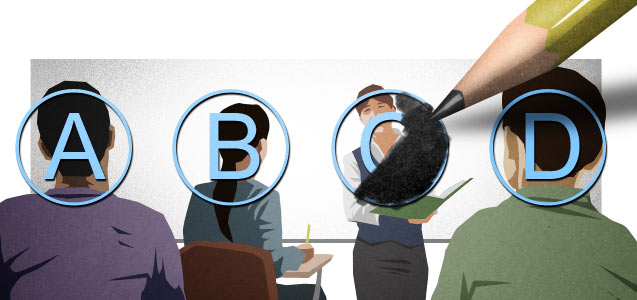It’s FSA season again. Every year in British Columbia, every student in grades four and seven has their regular classroom schedule put on hold for two weeks while they complete the Foundation Skills Assessment (FSA) — a collection of standardized tests mandated by the provincial government.
Every student, parent, teacher and citizen should oppose these tests. There is a litany of reasons for this, but top among them is the role standardized tests play in the very destruction of public education itself — by privatizing a public service. Masquerading as a test for system quality, they are in fact an instrument of system change, and not change for the better.
The origin and rationale for standardized testing dates back to the cold war. As early as the 1960s, the U.S. National Assessment of Educational Progress (NEAP), funded with a grant from the Carnegie Corporation, was promoting the use of standardized exams for comparison of states and districts. The so-called “need” for testing was ramped up in the infamous report A Nation at Risk, published by the U.S. government during the Reagan administration in 1983. The report insisted that America’s schools had to do better to fend off the Soviet threat.
As an international phenomenon, testing was promulgated by the OECD in the 1990s. It developed the Programme for International Student Assessment, PISA, as a way to measure member states and compare their education systems. Since this time, member states of the OECD have been only too happy to comply. State-wide testing was mandated federally in the U.S. through the notorious No Child Left Behind act. B.C. has the FSAs. Ontario the EQAO.
B.C.’s province wide standardized exam system has been in use since 1974, but it has changed over time. The first testing program, administered in grades four, eight and 12, was called the Provincial Learning Assessment Program (PLAP), and was a replacement of IQ tests. The results of the PLAP were not published but rather used internally for curriculum review and to manage the school system. But in 1984 the B.C. government decided to publish the results of Grade 12 provincial exams and by 1998 the Fraser Institute published its first ranking of B.C. schools. In 2002 the B.C. Liberals abolished the school accreditation system altogether and now relies on Accountability Contracts from each school district to ensure school quality. These documents, produced by school boards, in turn rely heavily on FSA test scores and are of dubious quality. All FSA results are now routinely made available by government on their web site and the Fraser Institute publishes rankings annually. Media outlets gleefully report on the best and worst schools.
Thus the FSAs, like standardized testing in many jurisdictions, has morphed in the last half century from a mechanism designed to internally review the quality of an individual education system, to a comparison tool to rank schools and districts.
The changes that took place are not accidental. They are part and parcel of the usual fare of neoliberalism: deregulation, defunding, market based provision of services, and privatization. How does this work? In today’s B.C. school system, a parent can pick up the Fraser Institute rankings and use them to choose a school. Because we no longer have closed school boundaries based on neighborhoods, they can register their child in the school of their choice. As their child progresses, they have access to a litany of special programs, such as Sports Academies and International Baccalaureate, many of which provide enhanced services through additional fees. Of course it is some parents choosing to do this — typically immigrant families and low income families simply send their children to the neighborhood school. Many districts are therefore experiencing a form of “white flight” out of inner city schools.
If you were Milton Friedman, one of the intellectual architects of neoliberal policy, you would look at this happily as a variant of what he called school vouchers. Acknowledging that even in the free-est of markets, the state has a role to play to ensure basic literacy levels, he advocated that all parents receive a voucher for their state education allowance with the ability to use it at the school of their choice. Now admittedly in Friedman’s world, these schools would be privately administered, but the mechanism for parent choice (testing and ranking), the market of schools, and the additional resources provided through school fees all mimic the Friedman model. The virtual school voucher is the provincial funding that follows a child to attend the school of their choice.
The U.S. has taken the testing craze a few more steps. Not only do they have an insane battery of tests (at least two every year from grades three to eight), but they have attached high stakes to these tests so that every aspect of the school system becomes “accountable” to a test score. If a school does badly, close it. If a teacher doesn’t improve student test scores, fire the teacher. If universities graduate new teachers whose students do badly, shut down the teacher preparation school.
Unfortunately, the test scores mostly reflect one thing — the socioeconomic status of the student writing the test. The inevitable result, therefore, is that it is poor (and disproportionately black) students who are losing their teachers and losing their schools. It is no accident that the first jurisdiction to have no public schools remaining at all is New Orleans.
We can learn from our neighbours to the south, where a growing anti-test movement is sweeping the country. We have the opportunity to scrap the testing and ranking before it completely takes over our public school system. If you are a parent, please withdraw your student from the FSA. If you are a teacher, please work with your colleagues to encourage parents and others to refuse to take the tests. If you are anyone else, work with teachers and parents to end the testing mania and advocate for a school system administered by and for the public.
Image: Flickr/truthout



